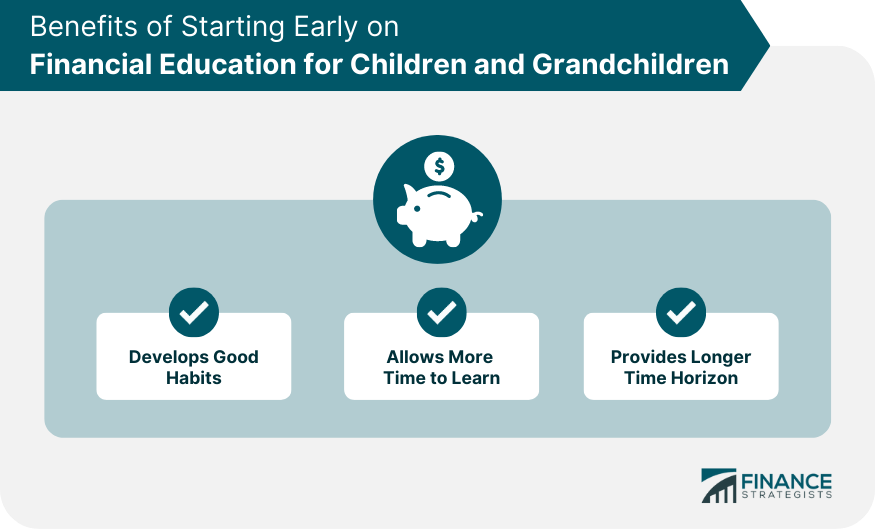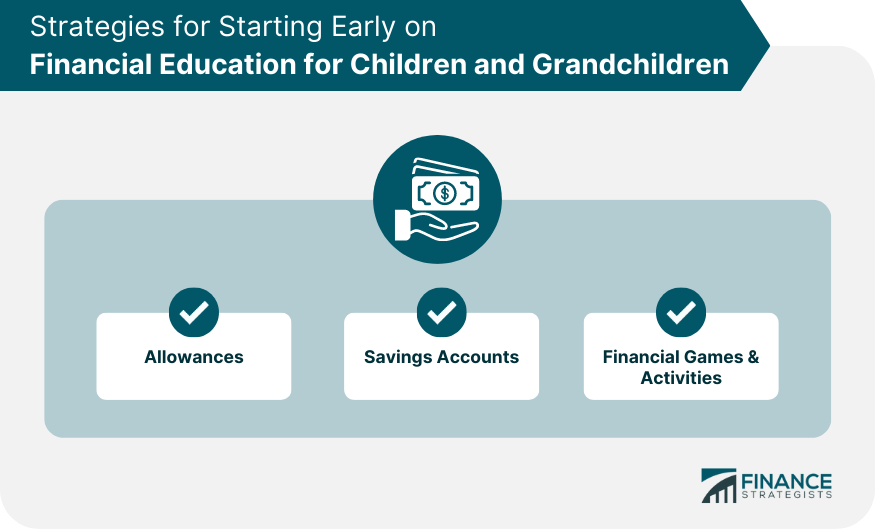Financial education for children and grandchildren is the process of teaching young people about financial concepts, such as budgeting, saving, investing, and managing debt. The goal of financial education is to provide young people with the knowledge and skills necessary to make informed financial decisions throughout their lives. Financial education for children and grandchildren can take many forms, including classroom education, online resources, books, and hands-on activities. It can start as early as preschool, where children can learn basic money concepts like counting, saving, and spending. As children get older, financial education can become more complex and focus on topics such as credit, loans, and taxes. Providing financial education to children and grandchildren is crucial for their long-term financial well-being. By starting early, they can develop good habits, gain valuable knowledge, and establish a strong foundation for a successful financial future. Starting financial education early enables children and grandchildren to develop good financial habits from a young age. By learning the importance of saving, budgeting, and responsible spending, they are more likely to make wise financial decisions as adults. By introducing financial concepts to children and grandchildren early, they have more time to learn and understand these ideas. This allows them to become more comfortable with money management and develop confidence in their financial abilities. A longer time horizon allows children and grandchildren to reap the benefits of compound interest and long-term investing. By starting early, they can take advantage of the power of compounding and grow their wealth over time. Providing children with an allowance can be an effective way to teach them about money management. This allows them to practice budgeting, saving, and spending, and helps them understand the value of money. Opening a savings account for your child or grandchild can help them learn about saving and interest. It also provides a safe place for them to store their money and watch it grow over time. Engaging children and grandchildren in financial games and activities can make learning about money management fun and interactive. These activities can help them understand financial concepts in a more relatable and enjoyable way. Encouraging children and grandchildren to set financial goals can help them develop a sense of purpose and direction when it comes to managing their money. This can include short-term goals, like saving for a toy, or long-term goals, such as saving for college. Teaching children and grandchildren to track their expenses can help them understand where their money is going and identify areas where they can cut back or save. This skill is essential for maintaining a healthy budget and avoiding overspending. Helping children and grandchildren differentiate between needs and wants can be crucial in developing responsible spending habits. By understanding the difference, they can make more informed decisions about how to allocate their money. Encouraging children and grandchildren to set savings goals can help them develop a sense of accomplishment and motivate them to save consistently. By working towards a specific goal, they can learn the importance of delayed gratification and financial discipline. Promoting regular deposits into a savings account can help children and grandchildren develop the habit of saving consistently. This can be done through automatic transfers or by setting aside a portion of their allowance or earnings. Offering incentives for reaching savings goals can motivate children and grandchildren to save even more. This can include matching their savings, providing rewards, or offering praise and encouragement. Teaching children and grandchildren the difference between saving and investing can help them understand the importance of both strategies in building wealth. While saving provides security, investing offers the potential for growth and higher returns over time. Introducing the concepts of interest and compound interest can help children and grandchildren grasp the power of their savings and investments. By understanding how their money can grow over time, they can appreciate the benefits of consistent saving and long-term investing. Educating children and grandchildren about the relationship between risk and return can help them make informed decisions when it comes to investing. By understanding that higher returns often come with higher risks, they can learn to balance their investment portfolios according to their risk tolerance. Introducing children and grandchildren to various investment options, such as stocks, bonds, and mutual funds, can help them become familiar with different investment vehicles. This knowledge can enable them to make informed decisions when building their investment portfolios. Teaching children and grandchildren about diversification can help them understand the importance of spreading their investments across different assets. By diversifying their portfolios, they can reduce risk and increase the potential for more stable returns. Discussing investment risks with children and grandchildren can help them recognize that all investments come with some degree of risk. By understanding the various types of risks, they can make more informed decisions and manage their investments effectively. Educating children and grandchildren about credit scores and their impact on financial opportunities is essential for their future financial success. By understanding the importance of a good credit score, they can make responsible credit decisions and maintain a healthy credit history. Teaching children and grandchildren about the dangers of excessive debt can help them avoid financial pitfalls later in life. By learning to manage their credit responsibly and prioritize debt repayment, they can maintain financial stability. Introducing responsible credit card use to children and grandchildren can help them build a strong credit history and avoid the dangers of credit card debt. This includes understanding interest rates, payment due dates, and the importance of paying off the balance in full each month. Financial education for children and grandchildren is crucial for their long-term financial well-being. It is a process of teaching young people about financial concepts such as budgeting, saving, investing, and managing debt. By starting early, children and grandchildren can develop good habits, gain valuable knowledge, and establish a strong foundation for a successful financial future. Some of the benefits of starting financial education early include developing good habits, having more time to learn, and a longer time horizon. There are various strategies for starting financial education early such as establishing a budget, setting financial goals, teaching saving, introducing basic financial concepts, and discussing credit. These strategies can help children and grandchildren become financially literate, make informed financial decisions, and lead successful financial lives.What Is Financial Education for Children and Grandchildren?
Benefits of Starting Early on Financial Education for Children and Grandchildren
Develops Good Habits
Allows More Time to Learn
Provides Longer Time Horizon

Strategies for Starting Early on Financial Education for Children and Grandchildren
Allowances
Savings Accounts
Financial Games and Activities

Teaching Children and Grandchildren to Establish a Budget
Setting Financial Goals
Tracking Expenses
Identifying Needs vs. Wants
Teaching Savings Strategies to Children and Grandchildren
Setting Savings Goals
Encouraging Regular Deposits
Providing Incentives
Introducing Children and Grandchildren to Basic Financial Concepts
Saving vs. Investing
Interest and Compound Interest
Risk and Return
Encouraging Children and Grandchildren to Invest
Investment Options
Importance of Diversification
Investment Risks
Discussing Credit With Children and Grandchildren
Understanding Credit Scores
Avoiding Debt
Responsible Credit Card Use
Conclusion
Financial Education for Children and Grandchildren FAQs
Financial education for children and grandchildren is the process of teaching young people about financial concepts, such as budgeting, saving, investing, and managing debt. The goal of financial education is to provide young people with the knowledge and skills necessary to make informed financial decisions throughout their lives.
Financial education is essential because it teaches children and grandchildren important skills they'll need to manage their finances as adults.
Budgeting, saving, investing, and credit are some of the critical topics that should be covered in financial education for children and grandchildren.
It's never too early to start teaching financial education. Introducing basic concepts as early as possible is the best strategy.
Parents and grandparents can use different strategies such as allowances, savings accounts, financial games and activities, and leading by example to teach financial education.
True Tamplin is a published author, public speaker, CEO of UpDigital, and founder of Finance Strategists.
True is a Certified Educator in Personal Finance (CEPF®), author of The Handy Financial Ratios Guide, a member of the Society for Advancing Business Editing and Writing, contributes to his financial education site, Finance Strategists, and has spoken to various financial communities such as the CFA Institute, as well as university students like his Alma mater, Biola University, where he received a bachelor of science in business and data analytics.
To learn more about True, visit his personal website or view his author profiles on Amazon, Nasdaq and Forbes.











